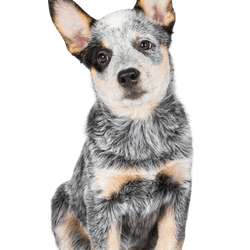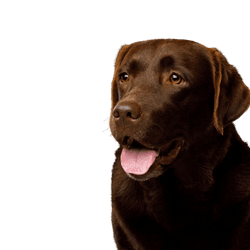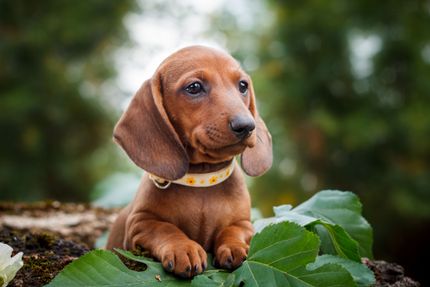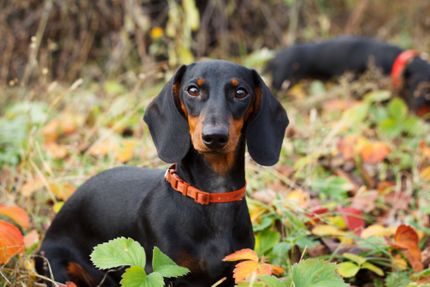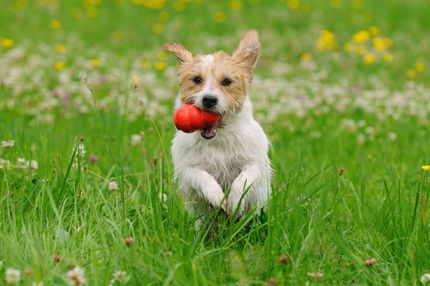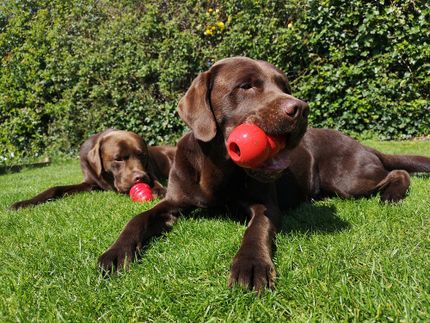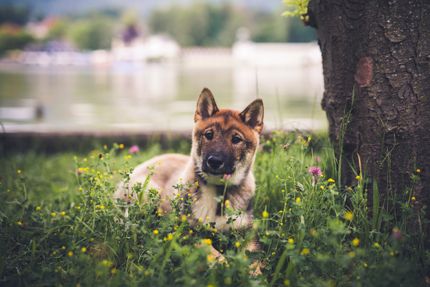Labraheeler:Australian Cattle Dog and Labrador Retriever Mix
Facts & Origin
Labrador Retriever and Australian Cattle Dog Mix - a hybrid breed
Are you looking for a loyal and active dog? The Labrador Retriever and Australian Cattle Dog mix is the perfect puppy for you! These dogs are known for their abilities as service dogs and make great family pets.
What are breed characteristics of this mix dog?
The Labrador Retriever Australian Cattle Dog mix has a muscular body with a deep chest. They are medium to large dogs that weigh between 25-45 kg and measure 56-69 cm at the shoulder. They have a short, dense coat that is either black, brown or red with white markings. They have a broad head with a square muzzle and floppy ears. Their tail is thick and tapered and their eyes are dark brown.
| Alternate Name | - |
| Origin | Australia - UK |
| Life expectancy | 10 - 14 years |
| Care requirements | low-maintenance |
| Activity level | average |
| FCI group | not recognised |
| AKC group | not recognised |
| KC group | not recognised |
More Australian Cattle Dog mixes
More Labrador Retriever mixes
Attitude, character and temperament of the breed
Possible character traits of Labrador Retriever and Australian Cattle Dog Mix - Such is probably his nature.
In search of a loyal and protective companion, many people consider adopting a Labrador Retriever. But what about a Labrador Retriever and Australian Cattle Dog mix? These dogs are a cross between two of the most popular breeds in the world, and they make great companions for families and individuals.
Labradors are known for their friendly nature and fondness for food, while Australian Cattle Dogs are more independent and reserved. However, when these two breeds are mixed together, the result is a dog that is loyal, protective, loving, and has a sense of adventure.
If you are toying with the idea of adding a furry friend to your family, consider a Labrador Retriever and an Australian Cattle Dog mix. You won't be disappointed.
Character
Usage


Health and breeding information
What diseases can occur in Labrador Retriever and Australian Cattle Dog mix.
The Labrador Retriever Australian Cattle Dog mix is a relatively new mixed breed dog that is becoming increasingly popular. While this breed does have some potential health issues that owners should be aware of, the overall health of the breed is good. The most common health problems in the Labrador Retriever Australian Cattle Dog mix include hip and elbow dysplasia, eye problems and obesity.
Hip and elbow dysplasia are two of the most common problems that occur in larger dog breeds, and the Labrador Retriever Australian Cattle Dog mix is no exception. Both problems are caused by deformities of the joints that can lead to pain and arthritis as the dog ages. Dysplasia can be managed with weight management and exercise, but it is often necessary to see a veterinarian to treat the symptoms.
Eye problems are also relatively common in the Labrador Retriever Australian Cattle Dog mix. The most common eye problems that occur in this breed include cataracts, glaucoma, and progressive retinal atrophy. These problems can often be managed with regular veterinary examinations and early detection, but can eventually lead to blindness.
Finally, obesity is a common health problem in the Labrador Retriever-Australian Cattle Dog mix. This breed tends to gain weight, so owners must be careful not to overfeed their dog. Obesity can lead to a number of other health problems, including joint problems, respiratory problems and even heart disease. The best prevention for obesity and other related health problems is to keep your dog's weight at a healthy level.
What does this mixed breed look like?
The Labrador Retriever Australian Cattle Dog Mix breed has a short, dense coat that is black, brown or tan. The coat is low maintenance and requires little grooming.
| Fur length | short |
| Fur | - flat coated |
| Ear shape | Standing Ears - Triangle |
| Tail | fanned out - lang |
| Anatomy | rugged, rugged, massive |
| Size ♀ | 43 - 60 cm |
| Weight ♀ | 14 - 32 kg |
| Size ♂ | 46 - 63 cm |
| Weight ♂ | 15 - 32 kg |
| Suitable For | - |
Known Diseases
Eye infections
Chronic eye infections can be very painful in dogs and can be treated with medication. In rare cases, the cornea must be treated.
Nervous disorders
Nervous disorders are manifested, for example, by disturbances in perception, neurological abnormalities such as tremors, apathy, convulsions, paralysis, tilting of the head, uncontrolled urination and defecation, and behavioural abnormalities.
Numbness
Often occurs in old age.
Eye diseases
Often occur with allergies and intolerances.
Elbow dysplasia (ED)
Elbow joint dysplasia is a chronic disease complex of the elbow joint of fast growing dog breeds.
Joint damage
In some breeds, joint damage can occur later in life, affecting the musculoskeletal system.
Hip dysplasia (HD)
The hip dysplasia or hip joint dysplasia of the dog (HD) is a maldevelopment of the hip joint.
Overweight
Often, unfortunately, the dogs very much under excess weight. But the dogs themselves are never to blame!
FAQ
-
A Labrador Retriever and Australian Cattle Dog mix is a cross between two popular dog breeds, the Labrador Retriever and the Australian Cattle Dog. These two breeds were chosen for their compatibility with each other and their ability to produce a healthy, versatile dog.
-
A Labraheeler, as they are sometimes called, can vary greatly in appearance. However, most have the characteristic short, dense coat of the Labrador Retriever and the head and body shape of the Australian Cattle Dog.
-
Labraheeler are generally active, friendly and intelligent dogs. They make excellent family pets and are known to be good with children.
-
Labraheeler need the same care as any other dog. They should be fed high quality food, get plenty of exercise and receive regular veterinary checkups and vaccinations.
-
Yes! Labrador Retriever and Australian Cattle Dog mixes make great family dogs. They usually get along well with children and other pets and are relatively easy to train.
Useful Articles
You can find articles that might interest you in the dogbible blog to match your favorite breed.
Visit our magazineto stay up to date on dog trends.
To find out more, view our Privacy Policy
Find here the breed that suits you and find out what character traits it has. Here you can also learn more about the origin, size and weight of your favorite breeds.
Matching your favorite breed, you'll find articles that might interest you on the dogbible dog blog.
Chronic ear infection in dogs - what you can do
Real Nature dog food - experience review and is it really that good?
Can dogs sweat? Tips against overheating in dogs
Spirulina for dog - why do you need it?
Cancer in dogs - cause, diagnosis, prevention of cancer in dogs
